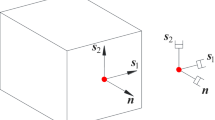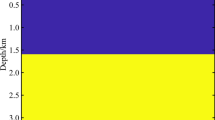Abstract
The three-dimensional numerical manifold method (3DNMM) method is further enriched to simulate wave propagation across homogeneous/jointed rock masses. For the purpose of minimizing negative effects from artificial boundaries, a viscous non-reflecting boundary, which can effectively absorb the energy of a wave, is firstly adopted to enrich 3DNMM. Then, to simulate the elastic recovery property of an infinite problem domain, a viscoelastic boundary, which is developed from the viscous nonreflecting boundary, is further adopted to enrich 3DNMM. Finally, to eliminate the noise caused by scattered waves, a force input method which can input the incident wave correctly is incorporated into 3DNMM. Five typical numerical tests on P/S-wave propagation across jointed/homogeneous rock masses are conducted to validate the enriched 3DNMM. Numerical results indicate that wave propagation problems within homogeneous and jointed rock masses can be correctly and reliably modeled with the enriched 3DNMM.
Similar content being viewed by others
References
Zhu J B, Zhao G F, Zhao X B, et al. Validation study of the distinct lattice spring model (DLSM) on P-wave propagation across multiple parallel joints. Comput Geotech, 2011, 38: 298–304
Zhao G. Modeling stress wave propagation in rocks by distinct lattice spring model. J Rock Mech Geotech Eng, 2014, 6: 348–355
Schoenberg M. Elastic wave behavior across linear slip interfaces. J Acoust Soc Am, 1980, 68: 1516–1521
Zhao J, Cai J G, Zhao X B, et al. Experimental study of ultrasonic wave attenuation across parallel fractures. Geomech Geoeng, 2006, 1: 87–103
Li J, Ma G, Zhao J. An equivalent viscoelastic model for rock mass with parallel joints. J Geophys Res, 2010, 115: 2008JB006241
Zienkiewicz O C, Taylor R L. The Finite Element Method. 5th ed. Oxford: Butterworth-Heinemann, 2000
Shimizu H, Murata S, Ishida T. The distinct element analysis for hydraulic fracturing in hard rock considering fluid viscosity and particle size distribution. Int J Rock Mech Min Sci, 2011, 48: 712–727
Fu X, Sheng Q, Zhang Y, et al. Application of the discontinuous deformation analysis method to stress wave propagation through a one-dimensional rock mass. Int J Rock Mech Min Sci, 2015, 80: 155–170
Shi G H. Discontinuous deformation analysis—A new numerical model for the statics and dynamics of block systems. Dissertation for Doctoral Degree. Berkeley: Department of Civil Engineering, University of California, 1988
Tsesarsky M, Hatzor Y H. Tunnel roof deflection in blocky rock masses as a function of joint spacing and friction — A parametric study using discontinuous deformation analysis (DDA). Tunn Undergr Space Tech, 2006, 21: 29–45
Rabczuk T, Belytschko T. Cracking particles: A simplified meshfree method for arbitrary evolving cracks. Numer Meth Eng, 2004, 61: 2316–2343
Zhuang X, Augarde C E, Mathisen K M. Fracture modeling using meshless methods and level sets in 3D: Framework and modeling. Numer Meth Eng, 2012, 92: 969–998
Barla M, Piovano G, Grasselli G. Rock slide simulation with the combined finite-discrete element method. Int J Geomech, 2012, 12: 711–721
Munjiza A, Latham J P. Comparison of experimental and FEM/DEM results for gravitational deposition of identical cubes. Eng Computation, 2004, 21: 249–264
Mohammadnejad T, Khoei A R. An extended finite element method for hydraulic fracture propagation in deformable porous media with the cohesive crack model. Finite Elem Anal Des, 2013, 73: 77–95
**g L. A review of techniques, advances and outstanding issues in numerical modelling for rock mechanics and rock engineering. Int J Rock Mech Min Sci, 2003, 40: 283–353
Goodman R E. Methods of Geological Engineering in Discontinuous Rocks. New York: Wiley, 1976
Shi G H. Manifold method ofmaterial analysis. In: Proceedings of the Transcations of the Ninth Army Conference on Applied Mathematics and Computing. Minnesoda, 1991. 57–76
Yang Y, Zheng H. Direct approach to treatment of contact in numerical manifold method. Int J Geomech, 2017, 17: E4016012
Hu M, Rutqvist J, Wang Y. A practical model for fluid flow in discrete-fracture porous media by using the numerical manifold method. Adv Water Resources, 2016, 97: 38–51
Zhang G X, Li X, Li H F. Simulation of hydraulic fracture utilizing numerical manifold method. Sci China Tech Sci, 2015, 58: 1542–1557
Wu Z, Wong L N Y. Extension of numerical manifold method for coupled fluid flow and fracturing problems. Num Anal Meth Geo-Mech, 2014, 38: 1990–2008
Yang Y, Tang X, Zheng H, et al. Hydraulic fracturing modeling using the enriched numerical manifold method. Appl Math Model, 2018, 53: 462–486
Yang Y, Wu W, Zheng H. Investigation of slope stability based on strength-reduction-based numerical manifold method and generalized plastic strain. Int J Rock Mech Min Sci, 2023, 164: 105358
Wang H, Yang Y, Sun G, et al. A stability analysis of rock slopes using a nonlinear strength reduction numerical manifold method. Comput Geotech, 2021, 129: 103864
Zhao G F, Zhao X B, Zhu J B. Application of the numerical manifold method for stress wave propagation across rock masses. Num Anal Meth GeoMech, 2014, 38: 92–110
Wu Z, Fan L. The numerical manifold method for elastic wave propagation in rock with time-dependent absorbing boundary conditions. Eng Anal Bound Elem, 2014, 46: 41–50
Bao H, Hatzor Y H, Huang X. A new viscous boundary condition in the two-dimensional discontinuous deformation analysis method for wave propagation problems. Rock Mech Rock Eng, 2012, 45: 919–928
Yang Y, Guo H, Fu X, et al. Boundary settings for the seismic dynamic response analysis of rock masses using the numerical manifold method. Num Anal Meth GeoMech, 2018, 42: 1095–1122
Wei W, Zhao Q, Jiang Q, et al. Three new boundary conditions for the seismic response analysis of geomechanics problems using the numerical manifold method. Int J Rock Mech Min Sci, 2018, 105: 110–122
Fu X, Sheng Q, Zhang Y, et al. Boundary setting method for the seismic dynamic response analysis ofengineering rock mass structures using the discontinuous deformation analysis method. Int J Numer Anal Meth Geomech, 2015, 39: 1693–1712
He L, Ma G. Development of 3D numerical manifold method. Int J Comput Methods, 2010, 07: 107–129
Cheng Y M, Zhang Y H. Formulation of a three-dimensional numerical manifold method with tetrahedron and hexahedron elements. Rock Mech Rock Eng, 2008, 41: 601–628
Jiang Q H, Zhou C B, Zhang Y. A model of point-to-face contact for three-dimensional numerical manifold method. Chin J Comput Mech, 2006, 23: 569–572
Jiang Q H, Yeung M R. A model of point-to-face contact for three-dimensional discontinuous deformation analysis. Rock Mech Rock Eng, 2004, 37: 95–116
Yang Y, Tang X, Zheng H, et al. Three-dimensional fracture propagation with numerical manifold method. Eng Anal Bound Elem, 2016, 72: 65–77
Zheng H, Xu D. New strategies for some issues ofnumerical manifold method in simulation of crack propagation. Numer Meth Eng, 2014, 97: 986–1010
Yang Y, Wu W, Zheng H. Searching for critical slip surfaces ofslopes using stress fields by numerical manifold method. J Rock Mech Geotech Eng, 2020, 12: 1313–1325
Kuhlemeyer R L, Lysmer J. Finite element method accuracy for wave propagation problems. J Soil Mech Found Div, 1973, 99: 421–427
Zhang Y, Fu X, Sheng Q. Modification of the discontinuous deformation analysis method and its application to seismic response analysis of large underground caverns. Tunn Undergr Space Tech, 2014, 40: 241–250
Yang Y, Xu D, Zheng H, et al. Modeling wave propagation in rock masses using the contact potential-based three-dimensional discontinuous deformation analysis method. Rock Mech Rock Eng, 2021, 54: 2465–2490
Deeks A J, Randolph M F. Axisymmetric time-domain transmitting boundaries. J Eng Mech, 1994, 120: 25–42
Ning Y, Zhao Z. A detailed investigation of block dynamic sliding by the discontinuous deformation analysis. Num Anal Meth GeoMech, 2013, 37: 2373–2393
Liao Z P. Introduction to Wave Motion Theories in Engineering (in Chinese). 2nd ed. Bei**g: Science Press, 2002
Jiang Q, Chen Y, Zhou C, et al. Kinetic energy dissipation and convergence criterion of discontinuous deformations analysis (DDA) for geotechnical engineering. Rock Mech Rock Eng, 2013, 46: 1443–1460
Liu J B, Lu Y D. A direct method for analysis of dynamic soil-structure interaction based on interface idea. In: Dynamic Soil-Structure Interaction: Current Research in China and Switzerland. Bei**g, 1998. 261–276
Zhao X B, Zhao J, Cai J G, et al. UDEC modelling on wave propagation across fractured rock masses. Comput Geotech, 2008, 35: 97–104
Author information
Authors and Affiliations
Corresponding author
Additional information
This work was supported by the Youth Innovation Promotion Association CAS (Grant No. 2020327) and the National Natural Science Foundation of China (Grant Nos. 12202024, 52130905, 12272393, and 12072357).
Rights and permissions
About this article
Cite this article
Yang, Y., Li, J. & Wu, W. Modeling wave propagation across rock masses using an enriched 3D numerical manifold method. Sci. China Technol. Sci. 67, 835–852 (2024). https://doi.org/10.1007/s11431-023-2517-8
Received:
Accepted:
Published:
Issue Date:
DOI: https://doi.org/10.1007/s11431-023-2517-8




